University Hospital: Sally Brown Case Study - Nursing Intervention
VerifiedAdded on 2023/01/18
|7
|2660
|26
Case Study
AI Summary
This case study examines the case of Sally Brown, a 15-year-old girl who sustained a head injury while skateboarding. The assignment details the initial assessment using the Glasgow Coma Scale (GCS), the observations of the registered nurse, and the evolution of her condition. It explores the four phases of the flag program, including initial assessment, clinical review, rapid response, and advanced life support. The role of the registered nurse is emphasized, particularly in continuous assessment, medication management (morphine and oxycodone), and the development of treatment plans. The case highlights the importance of adapting treatment based on the patient's changing condition, the significance of psychological support, and the long-term care required in trauma cases. The study emphasizes the importance of the nursing department to take care of the patient after the treatment as well.

TITLE: SALLY BROWN CASE STUDY
NAME
UNIVERSITY
SUPERVISOR
NAME
UNIVERSITY
SUPERVISOR
Paraphrase This Document
Need a fresh take? Get an instant paraphrase of this document with our AI Paraphraser
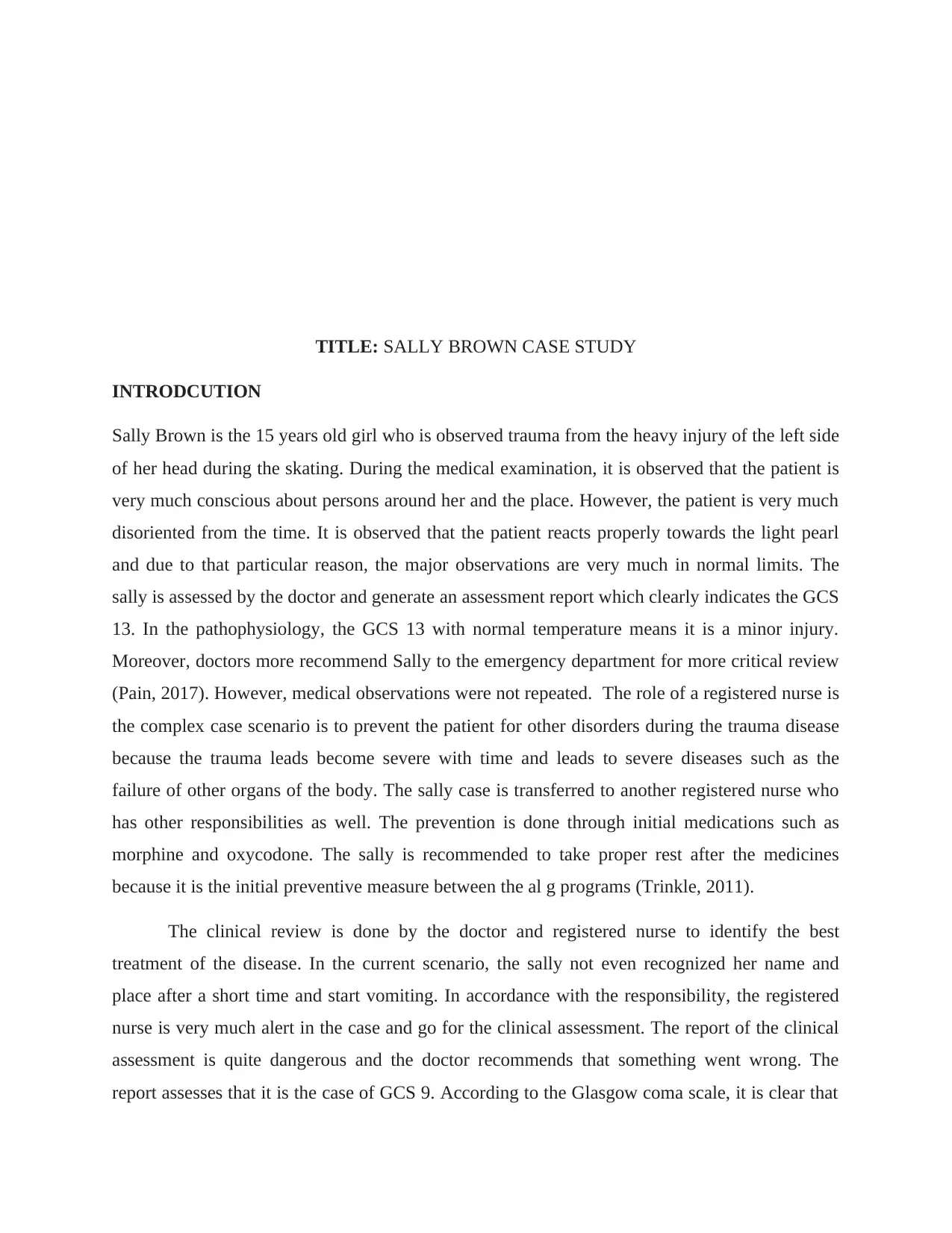
TITLE: SALLY BROWN CASE STUDY
INTRODCUTION
Sally Brown is the 15 years old girl who is observed trauma from the heavy injury of the left side
of her head during the skating. During the medical examination, it is observed that the patient is
very much conscious about persons around her and the place. However, the patient is very much
disoriented from the time. It is observed that the patient reacts properly towards the light pearl
and due to that particular reason, the major observations are very much in normal limits. The
sally is assessed by the doctor and generate an assessment report which clearly indicates the GCS
13. In the pathophysiology, the GCS 13 with normal temperature means it is a minor injury.
Moreover, doctors more recommend Sally to the emergency department for more critical review
(Pain, 2017). However, medical observations were not repeated. The role of a registered nurse is
the complex case scenario is to prevent the patient for other disorders during the trauma disease
because the trauma leads become severe with time and leads to severe diseases such as the
failure of other organs of the body. The sally case is transferred to another registered nurse who
has other responsibilities as well. The prevention is done through initial medications such as
morphine and oxycodone. The sally is recommended to take proper rest after the medicines
because it is the initial preventive measure between the al g programs (Trinkle, 2011).
The clinical review is done by the doctor and registered nurse to identify the best
treatment of the disease. In the current scenario, the sally not even recognized her name and
place after a short time and start vomiting. In accordance with the responsibility, the registered
nurse is very much alert in the case and go for the clinical assessment. The report of the clinical
assessment is quite dangerous and the doctor recommends that something went wrong. The
report assesses that it is the case of GCS 9. According to the Glasgow coma scale, it is clear that
INTRODCUTION
Sally Brown is the 15 years old girl who is observed trauma from the heavy injury of the left side
of her head during the skating. During the medical examination, it is observed that the patient is
very much conscious about persons around her and the place. However, the patient is very much
disoriented from the time. It is observed that the patient reacts properly towards the light pearl
and due to that particular reason, the major observations are very much in normal limits. The
sally is assessed by the doctor and generate an assessment report which clearly indicates the GCS
13. In the pathophysiology, the GCS 13 with normal temperature means it is a minor injury.
Moreover, doctors more recommend Sally to the emergency department for more critical review
(Pain, 2017). However, medical observations were not repeated. The role of a registered nurse is
the complex case scenario is to prevent the patient for other disorders during the trauma disease
because the trauma leads become severe with time and leads to severe diseases such as the
failure of other organs of the body. The sally case is transferred to another registered nurse who
has other responsibilities as well. The prevention is done through initial medications such as
morphine and oxycodone. The sally is recommended to take proper rest after the medicines
because it is the initial preventive measure between the al g programs (Trinkle, 2011).
The clinical review is done by the doctor and registered nurse to identify the best
treatment of the disease. In the current scenario, the sally not even recognized her name and
place after a short time and start vomiting. In accordance with the responsibility, the registered
nurse is very much alert in the case and go for the clinical assessment. The report of the clinical
assessment is quite dangerous and the doctor recommends that something went wrong. The
report assesses that it is the case of GCS 9. According to the Glasgow coma scale, it is clear that
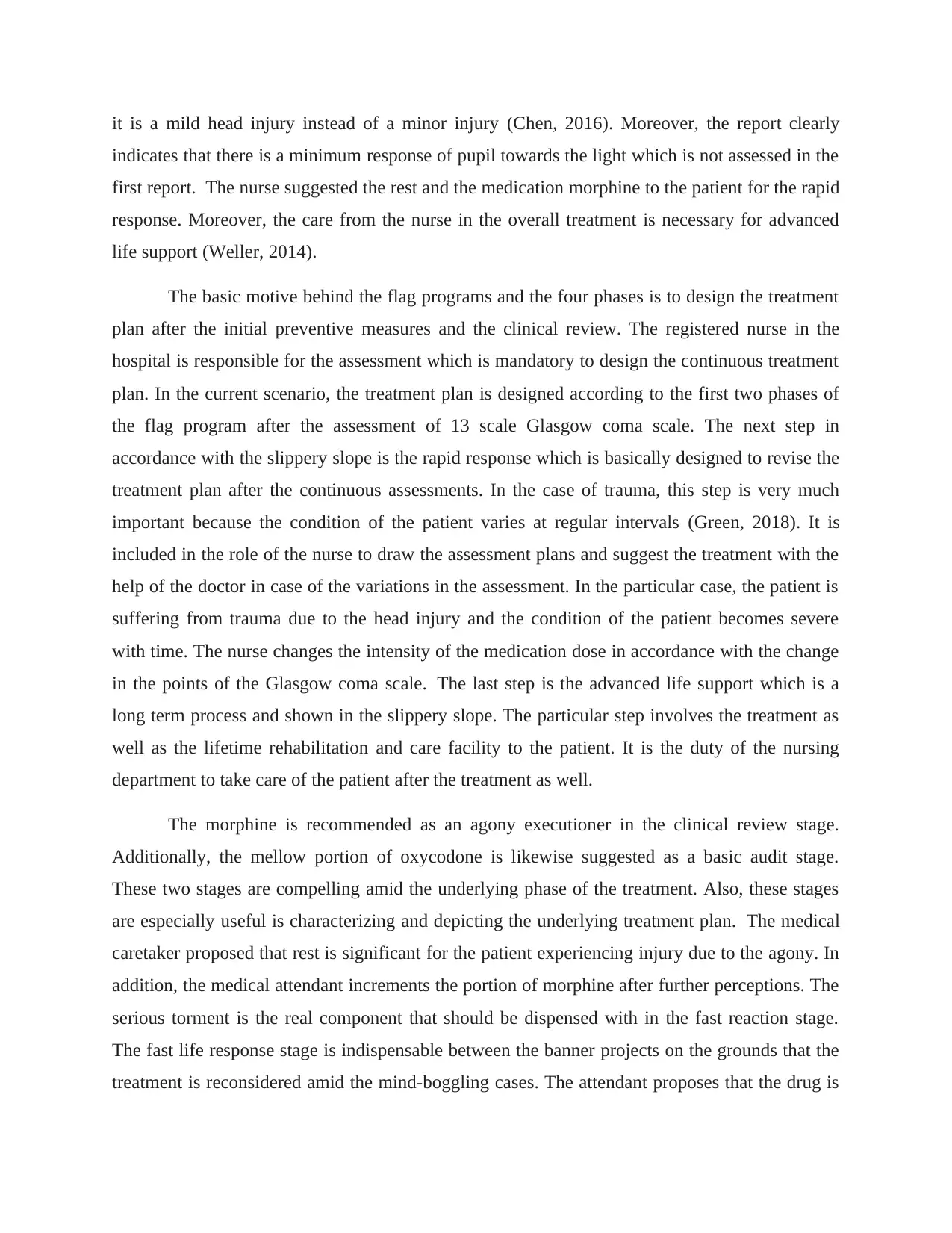
it is a mild head injury instead of a minor injury (Chen, 2016). Moreover, the report clearly
indicates that there is a minimum response of pupil towards the light which is not assessed in the
first report. The nurse suggested the rest and the medication morphine to the patient for the rapid
response. Moreover, the care from the nurse in the overall treatment is necessary for advanced
life support (Weller, 2014).
The basic motive behind the flag programs and the four phases is to design the treatment
plan after the initial preventive measures and the clinical review. The registered nurse in the
hospital is responsible for the assessment which is mandatory to design the continuous treatment
plan. In the current scenario, the treatment plan is designed according to the first two phases of
the flag program after the assessment of 13 scale Glasgow coma scale. The next step in
accordance with the slippery slope is the rapid response which is basically designed to revise the
treatment plan after the continuous assessments. In the case of trauma, this step is very much
important because the condition of the patient varies at regular intervals (Green, 2018). It is
included in the role of the nurse to draw the assessment plans and suggest the treatment with the
help of the doctor in case of the variations in the assessment. In the particular case, the patient is
suffering from trauma due to the head injury and the condition of the patient becomes severe
with time. The nurse changes the intensity of the medication dose in accordance with the change
in the points of the Glasgow coma scale. The last step is the advanced life support which is a
long term process and shown in the slippery slope. The particular step involves the treatment as
well as the lifetime rehabilitation and care facility to the patient. It is the duty of the nursing
department to take care of the patient after the treatment as well.
The morphine is recommended as an agony executioner in the clinical review stage.
Additionally, the mellow portion of oxycodone is likewise suggested as a basic audit stage.
These two stages are compelling amid the underlying phase of the treatment. Also, these stages
are especially useful is characterizing and depicting the underlying treatment plan. The medical
caretaker proposed that rest is significant for the patient experiencing injury due to the agony. In
addition, the medical attendant increments the portion of morphine after further perceptions. The
serious torment is the real component that should be dispensed with in the fast reaction stage.
The fast life response stage is indispensable between the banner projects on the grounds that the
treatment is reconsidered amid the mind-boggling cases. The attendant proposes that the drug is
indicates that there is a minimum response of pupil towards the light which is not assessed in the
first report. The nurse suggested the rest and the medication morphine to the patient for the rapid
response. Moreover, the care from the nurse in the overall treatment is necessary for advanced
life support (Weller, 2014).
The basic motive behind the flag programs and the four phases is to design the treatment
plan after the initial preventive measures and the clinical review. The registered nurse in the
hospital is responsible for the assessment which is mandatory to design the continuous treatment
plan. In the current scenario, the treatment plan is designed according to the first two phases of
the flag program after the assessment of 13 scale Glasgow coma scale. The next step in
accordance with the slippery slope is the rapid response which is basically designed to revise the
treatment plan after the continuous assessments. In the case of trauma, this step is very much
important because the condition of the patient varies at regular intervals (Green, 2018). It is
included in the role of the nurse to draw the assessment plans and suggest the treatment with the
help of the doctor in case of the variations in the assessment. In the particular case, the patient is
suffering from trauma due to the head injury and the condition of the patient becomes severe
with time. The nurse changes the intensity of the medication dose in accordance with the change
in the points of the Glasgow coma scale. The last step is the advanced life support which is a
long term process and shown in the slippery slope. The particular step involves the treatment as
well as the lifetime rehabilitation and care facility to the patient. It is the duty of the nursing
department to take care of the patient after the treatment as well.
The morphine is recommended as an agony executioner in the clinical review stage.
Additionally, the mellow portion of oxycodone is likewise suggested as a basic audit stage.
These two stages are compelling amid the underlying phase of the treatment. Also, these stages
are especially useful is characterizing and depicting the underlying treatment plan. The medical
caretaker proposed that rest is significant for the patient experiencing injury due to the agony. In
addition, the medical attendant increments the portion of morphine after further perceptions. The
serious torment is the real component that should be dispensed with in the fast reaction stage.
The fast life response stage is indispensable between the banner projects on the grounds that the
treatment is reconsidered amid the mind-boggling cases. The attendant proposes that the drug is
⊘ This is a preview!⊘
Do you want full access?
Subscribe today to unlock all pages.

Trusted by 1+ million students worldwide
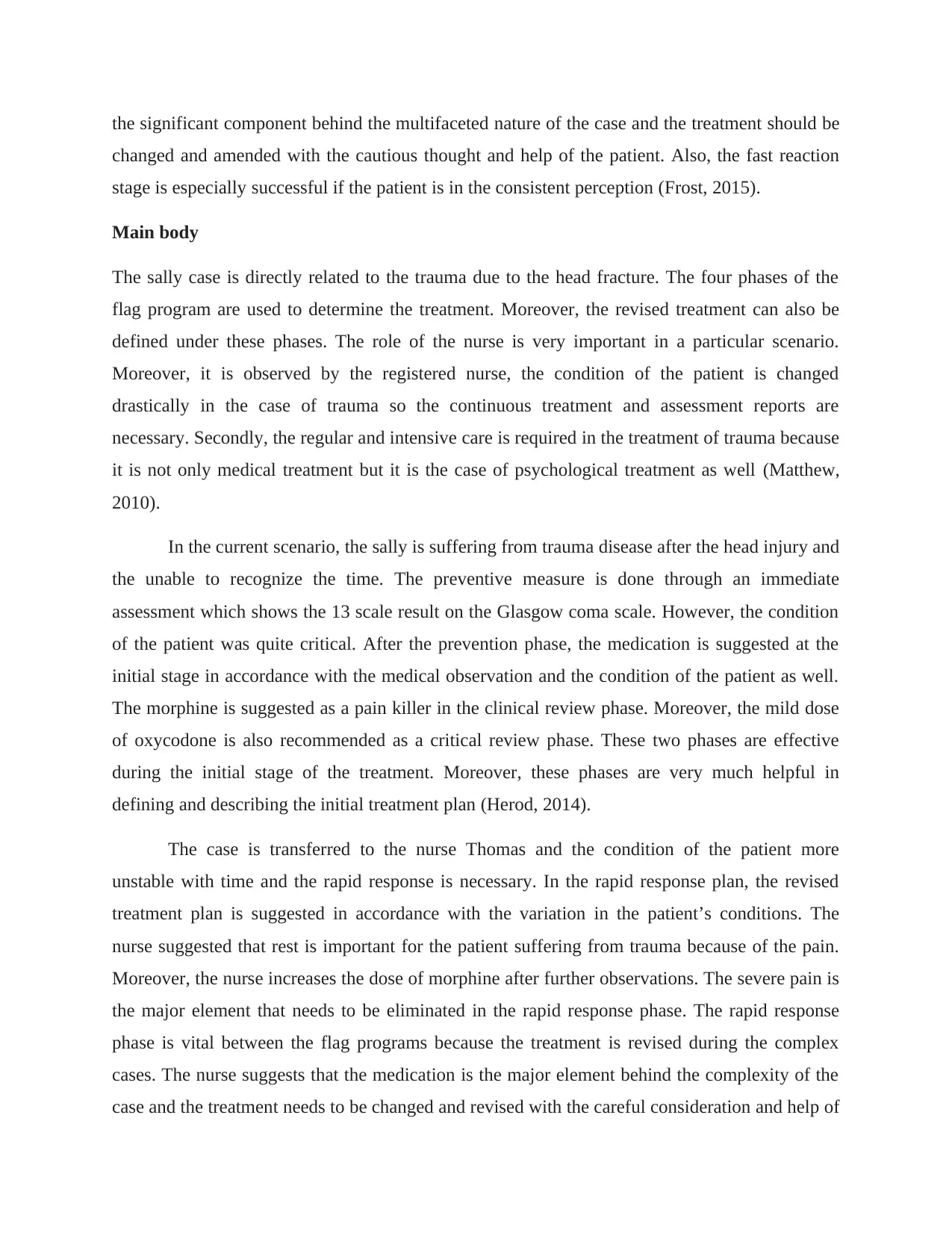
the significant component behind the multifaceted nature of the case and the treatment should be
changed and amended with the cautious thought and help of the patient. Also, the fast reaction
stage is especially successful if the patient is in the consistent perception (Frost, 2015).
Main body
The sally case is directly related to the trauma due to the head fracture. The four phases of the
flag program are used to determine the treatment. Moreover, the revised treatment can also be
defined under these phases. The role of the nurse is very important in a particular scenario.
Moreover, it is observed by the registered nurse, the condition of the patient is changed
drastically in the case of trauma so the continuous treatment and assessment reports are
necessary. Secondly, the regular and intensive care is required in the treatment of trauma because
it is not only medical treatment but it is the case of psychological treatment as well (Matthew,
2010).
In the current scenario, the sally is suffering from trauma disease after the head injury and
the unable to recognize the time. The preventive measure is done through an immediate
assessment which shows the 13 scale result on the Glasgow coma scale. However, the condition
of the patient was quite critical. After the prevention phase, the medication is suggested at the
initial stage in accordance with the medical observation and the condition of the patient as well.
The morphine is suggested as a pain killer in the clinical review phase. Moreover, the mild dose
of oxycodone is also recommended as a critical review phase. These two phases are effective
during the initial stage of the treatment. Moreover, these phases are very much helpful in
defining and describing the initial treatment plan (Herod, 2014).
The case is transferred to the nurse Thomas and the condition of the patient more
unstable with time and the rapid response is necessary. In the rapid response plan, the revised
treatment plan is suggested in accordance with the variation in the patient’s conditions. The
nurse suggested that rest is important for the patient suffering from trauma because of the pain.
Moreover, the nurse increases the dose of morphine after further observations. The severe pain is
the major element that needs to be eliminated in the rapid response phase. The rapid response
phase is vital between the flag programs because the treatment is revised during the complex
cases. The nurse suggests that the medication is the major element behind the complexity of the
case and the treatment needs to be changed and revised with the careful consideration and help of
changed and amended with the cautious thought and help of the patient. Also, the fast reaction
stage is especially successful if the patient is in the consistent perception (Frost, 2015).
Main body
The sally case is directly related to the trauma due to the head fracture. The four phases of the
flag program are used to determine the treatment. Moreover, the revised treatment can also be
defined under these phases. The role of the nurse is very important in a particular scenario.
Moreover, it is observed by the registered nurse, the condition of the patient is changed
drastically in the case of trauma so the continuous treatment and assessment reports are
necessary. Secondly, the regular and intensive care is required in the treatment of trauma because
it is not only medical treatment but it is the case of psychological treatment as well (Matthew,
2010).
In the current scenario, the sally is suffering from trauma disease after the head injury and
the unable to recognize the time. The preventive measure is done through an immediate
assessment which shows the 13 scale result on the Glasgow coma scale. However, the condition
of the patient was quite critical. After the prevention phase, the medication is suggested at the
initial stage in accordance with the medical observation and the condition of the patient as well.
The morphine is suggested as a pain killer in the clinical review phase. Moreover, the mild dose
of oxycodone is also recommended as a critical review phase. These two phases are effective
during the initial stage of the treatment. Moreover, these phases are very much helpful in
defining and describing the initial treatment plan (Herod, 2014).
The case is transferred to the nurse Thomas and the condition of the patient more
unstable with time and the rapid response is necessary. In the rapid response plan, the revised
treatment plan is suggested in accordance with the variation in the patient’s conditions. The
nurse suggested that rest is important for the patient suffering from trauma because of the pain.
Moreover, the nurse increases the dose of morphine after further observations. The severe pain is
the major element that needs to be eliminated in the rapid response phase. The rapid response
phase is vital between the flag programs because the treatment is revised during the complex
cases. The nurse suggests that the medication is the major element behind the complexity of the
case and the treatment needs to be changed and revised with the careful consideration and help of
Paraphrase This Document
Need a fresh take? Get an instant paraphrase of this document with our AI Paraphraser
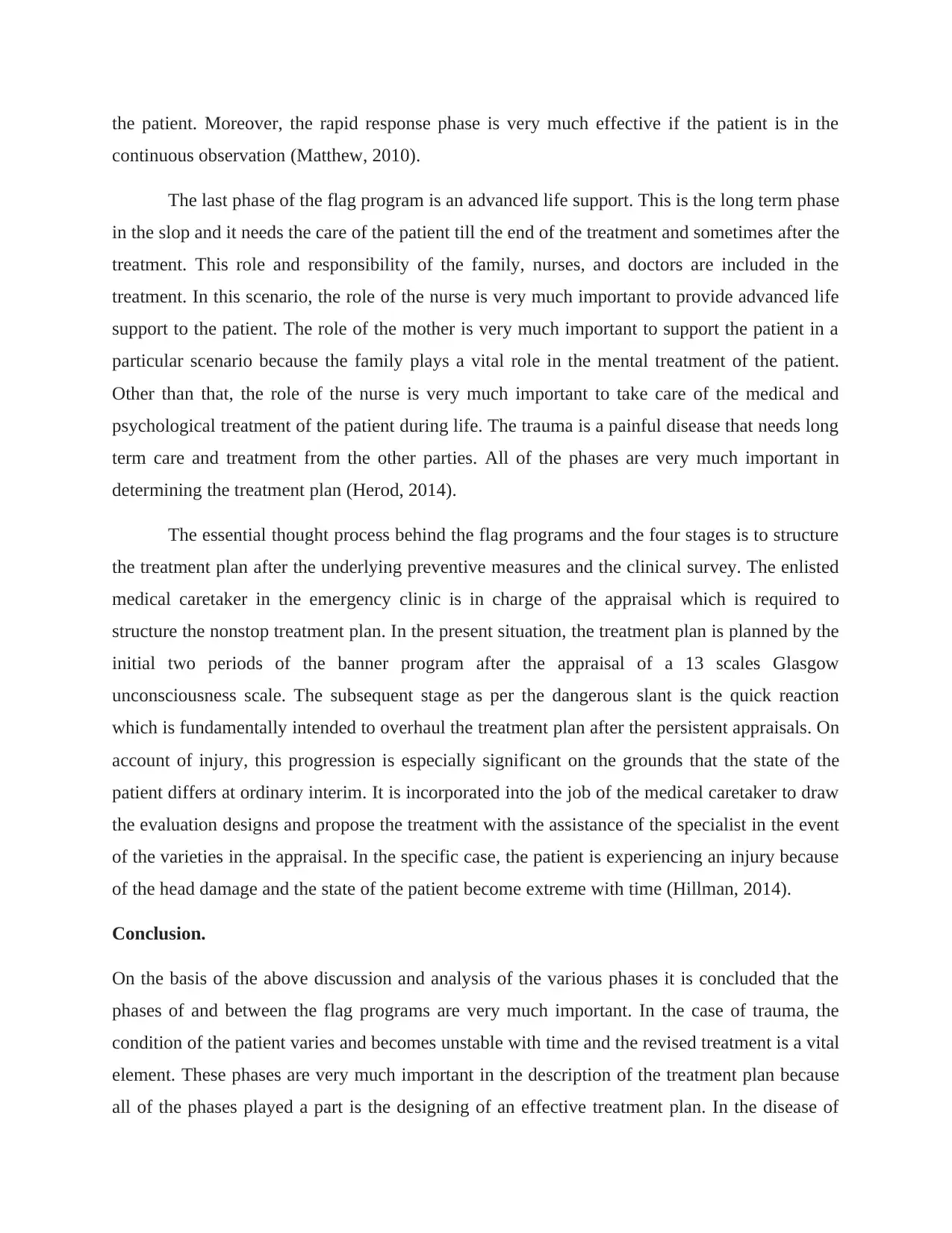
the patient. Moreover, the rapid response phase is very much effective if the patient is in the
continuous observation (Matthew, 2010).
The last phase of the flag program is an advanced life support. This is the long term phase
in the slop and it needs the care of the patient till the end of the treatment and sometimes after the
treatment. This role and responsibility of the family, nurses, and doctors are included in the
treatment. In this scenario, the role of the nurse is very much important to provide advanced life
support to the patient. The role of the mother is very much important to support the patient in a
particular scenario because the family plays a vital role in the mental treatment of the patient.
Other than that, the role of the nurse is very much important to take care of the medical and
psychological treatment of the patient during life. The trauma is a painful disease that needs long
term care and treatment from the other parties. All of the phases are very much important in
determining the treatment plan (Herod, 2014).
The essential thought process behind the flag programs and the four stages is to structure
the treatment plan after the underlying preventive measures and the clinical survey. The enlisted
medical caretaker in the emergency clinic is in charge of the appraisal which is required to
structure the nonstop treatment plan. In the present situation, the treatment plan is planned by the
initial two periods of the banner program after the appraisal of a 13 scales Glasgow
unconsciousness scale. The subsequent stage as per the dangerous slant is the quick reaction
which is fundamentally intended to overhaul the treatment plan after the persistent appraisals. On
account of injury, this progression is especially significant on the grounds that the state of the
patient differs at ordinary interim. It is incorporated into the job of the medical caretaker to draw
the evaluation designs and propose the treatment with the assistance of the specialist in the event
of the varieties in the appraisal. In the specific case, the patient is experiencing an injury because
of the head damage and the state of the patient become extreme with time (Hillman, 2014).
Conclusion.
On the basis of the above discussion and analysis of the various phases it is concluded that the
phases of and between the flag programs are very much important. In the case of trauma, the
condition of the patient varies and becomes unstable with time and the revised treatment is a vital
element. These phases are very much important in the description of the treatment plan because
all of the phases played a part is the designing of an effective treatment plan. In the disease of
continuous observation (Matthew, 2010).
The last phase of the flag program is an advanced life support. This is the long term phase
in the slop and it needs the care of the patient till the end of the treatment and sometimes after the
treatment. This role and responsibility of the family, nurses, and doctors are included in the
treatment. In this scenario, the role of the nurse is very much important to provide advanced life
support to the patient. The role of the mother is very much important to support the patient in a
particular scenario because the family plays a vital role in the mental treatment of the patient.
Other than that, the role of the nurse is very much important to take care of the medical and
psychological treatment of the patient during life. The trauma is a painful disease that needs long
term care and treatment from the other parties. All of the phases are very much important in
determining the treatment plan (Herod, 2014).
The essential thought process behind the flag programs and the four stages is to structure
the treatment plan after the underlying preventive measures and the clinical survey. The enlisted
medical caretaker in the emergency clinic is in charge of the appraisal which is required to
structure the nonstop treatment plan. In the present situation, the treatment plan is planned by the
initial two periods of the banner program after the appraisal of a 13 scales Glasgow
unconsciousness scale. The subsequent stage as per the dangerous slant is the quick reaction
which is fundamentally intended to overhaul the treatment plan after the persistent appraisals. On
account of injury, this progression is especially significant on the grounds that the state of the
patient differs at ordinary interim. It is incorporated into the job of the medical caretaker to draw
the evaluation designs and propose the treatment with the assistance of the specialist in the event
of the varieties in the appraisal. In the specific case, the patient is experiencing an injury because
of the head damage and the state of the patient become extreme with time (Hillman, 2014).
Conclusion.
On the basis of the above discussion and analysis of the various phases it is concluded that the
phases of and between the flag programs are very much important. In the case of trauma, the
condition of the patient varies and becomes unstable with time and the revised treatment is a vital
element. These phases are very much important in the description of the treatment plan because
all of the phases played a part is the designing of an effective treatment plan. In the disease of
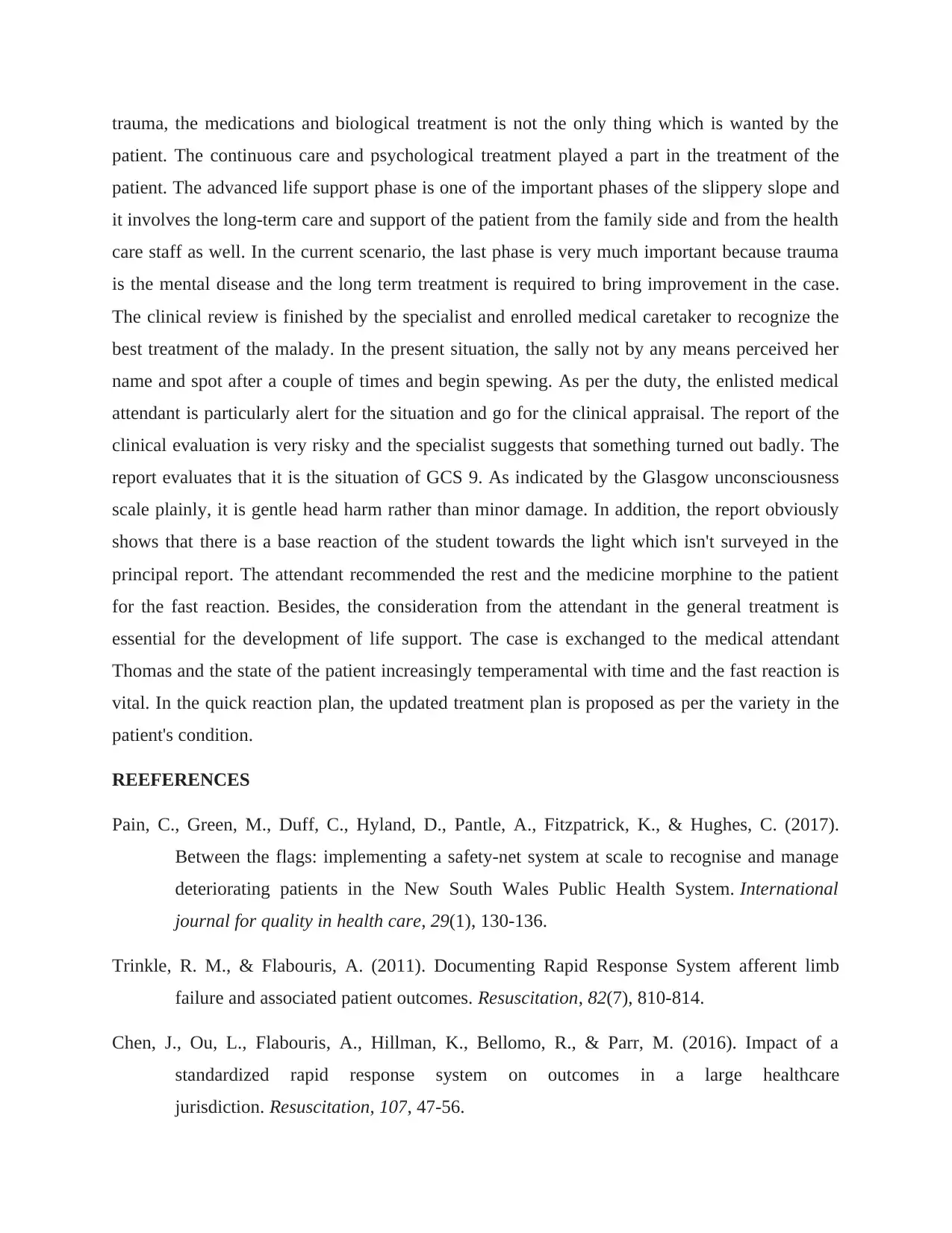
trauma, the medications and biological treatment is not the only thing which is wanted by the
patient. The continuous care and psychological treatment played a part in the treatment of the
patient. The advanced life support phase is one of the important phases of the slippery slope and
it involves the long-term care and support of the patient from the family side and from the health
care staff as well. In the current scenario, the last phase is very much important because trauma
is the mental disease and the long term treatment is required to bring improvement in the case.
The clinical review is finished by the specialist and enrolled medical caretaker to recognize the
best treatment of the malady. In the present situation, the sally not by any means perceived her
name and spot after a couple of times and begin spewing. As per the duty, the enlisted medical
attendant is particularly alert for the situation and go for the clinical appraisal. The report of the
clinical evaluation is very risky and the specialist suggests that something turned out badly. The
report evaluates that it is the situation of GCS 9. As indicated by the Glasgow unconsciousness
scale plainly, it is gentle head harm rather than minor damage. In addition, the report obviously
shows that there is a base reaction of the student towards the light which isn't surveyed in the
principal report. The attendant recommended the rest and the medicine morphine to the patient
for the fast reaction. Besides, the consideration from the attendant in the general treatment is
essential for the development of life support. The case is exchanged to the medical attendant
Thomas and the state of the patient increasingly temperamental with time and the fast reaction is
vital. In the quick reaction plan, the updated treatment plan is proposed as per the variety in the
patient's condition.
REEFERENCES
Pain, C., Green, M., Duff, C., Hyland, D., Pantle, A., Fitzpatrick, K., & Hughes, C. (2017).
Between the flags: implementing a safety-net system at scale to recognise and manage
deteriorating patients in the New South Wales Public Health System. International
journal for quality in health care, 29(1), 130-136.
Trinkle, R. M., & Flabouris, A. (2011). Documenting Rapid Response System afferent limb
failure and associated patient outcomes. Resuscitation, 82(7), 810-814.
Chen, J., Ou, L., Flabouris, A., Hillman, K., Bellomo, R., & Parr, M. (2016). Impact of a
standardized rapid response system on outcomes in a large healthcare
jurisdiction. Resuscitation, 107, 47-56.
patient. The continuous care and psychological treatment played a part in the treatment of the
patient. The advanced life support phase is one of the important phases of the slippery slope and
it involves the long-term care and support of the patient from the family side and from the health
care staff as well. In the current scenario, the last phase is very much important because trauma
is the mental disease and the long term treatment is required to bring improvement in the case.
The clinical review is finished by the specialist and enrolled medical caretaker to recognize the
best treatment of the malady. In the present situation, the sally not by any means perceived her
name and spot after a couple of times and begin spewing. As per the duty, the enlisted medical
attendant is particularly alert for the situation and go for the clinical appraisal. The report of the
clinical evaluation is very risky and the specialist suggests that something turned out badly. The
report evaluates that it is the situation of GCS 9. As indicated by the Glasgow unconsciousness
scale plainly, it is gentle head harm rather than minor damage. In addition, the report obviously
shows that there is a base reaction of the student towards the light which isn't surveyed in the
principal report. The attendant recommended the rest and the medicine morphine to the patient
for the fast reaction. Besides, the consideration from the attendant in the general treatment is
essential for the development of life support. The case is exchanged to the medical attendant
Thomas and the state of the patient increasingly temperamental with time and the fast reaction is
vital. In the quick reaction plan, the updated treatment plan is proposed as per the variety in the
patient's condition.
REEFERENCES
Pain, C., Green, M., Duff, C., Hyland, D., Pantle, A., Fitzpatrick, K., & Hughes, C. (2017).
Between the flags: implementing a safety-net system at scale to recognise and manage
deteriorating patients in the New South Wales Public Health System. International
journal for quality in health care, 29(1), 130-136.
Trinkle, R. M., & Flabouris, A. (2011). Documenting Rapid Response System afferent limb
failure and associated patient outcomes. Resuscitation, 82(7), 810-814.
Chen, J., Ou, L., Flabouris, A., Hillman, K., Bellomo, R., & Parr, M. (2016). Impact of a
standardized rapid response system on outcomes in a large healthcare
jurisdiction. Resuscitation, 107, 47-56.
⊘ This is a preview!⊘
Do you want full access?
Subscribe today to unlock all pages.

Trusted by 1+ million students worldwide
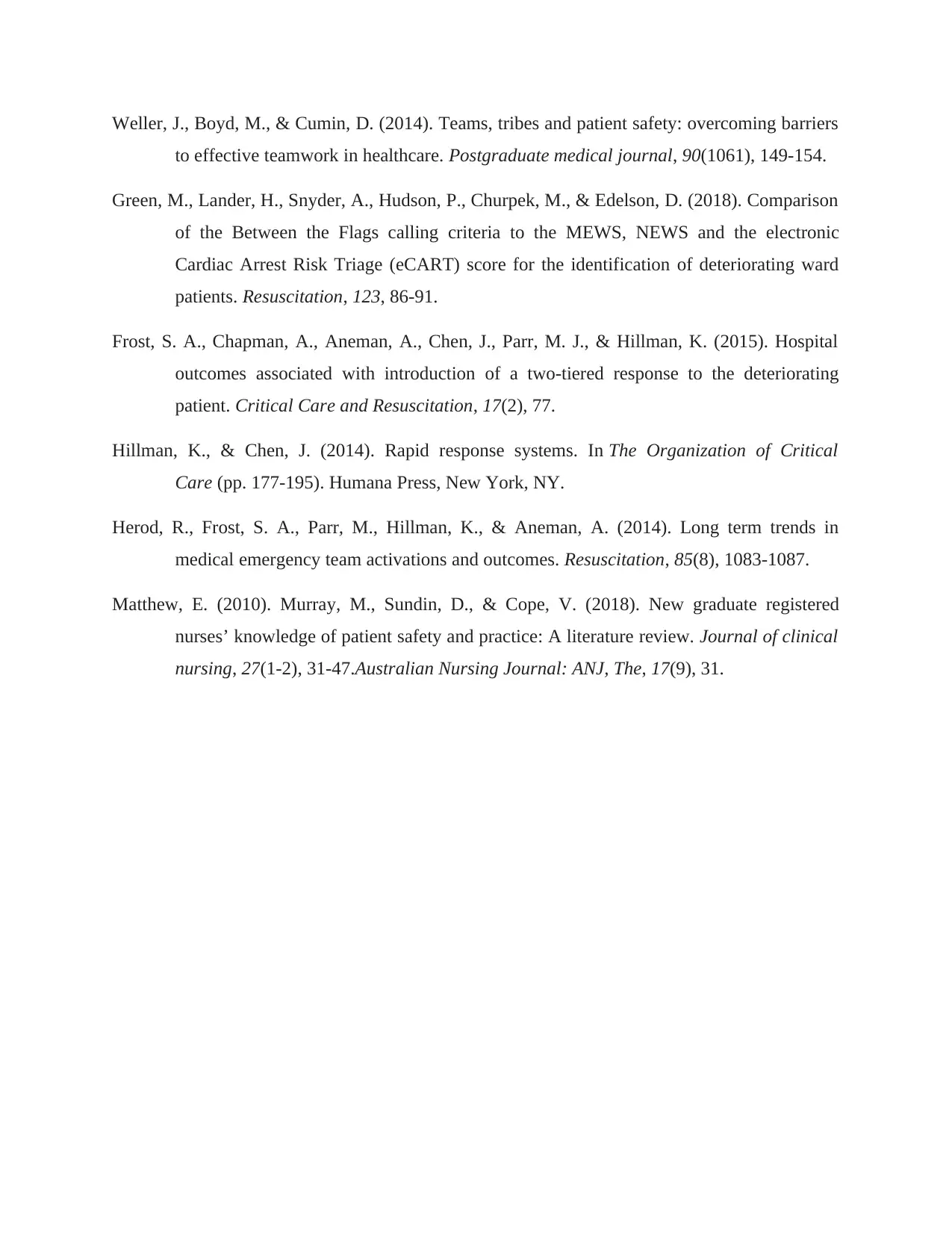
Weller, J., Boyd, M., & Cumin, D. (2014). Teams, tribes and patient safety: overcoming barriers
to effective teamwork in healthcare. Postgraduate medical journal, 90(1061), 149-154.
Green, M., Lander, H., Snyder, A., Hudson, P., Churpek, M., & Edelson, D. (2018). Comparison
of the Between the Flags calling criteria to the MEWS, NEWS and the electronic
Cardiac Arrest Risk Triage (eCART) score for the identification of deteriorating ward
patients. Resuscitation, 123, 86-91.
Frost, S. A., Chapman, A., Aneman, A., Chen, J., Parr, M. J., & Hillman, K. (2015). Hospital
outcomes associated with introduction of a two-tiered response to the deteriorating
patient. Critical Care and Resuscitation, 17(2), 77.
Hillman, K., & Chen, J. (2014). Rapid response systems. In The Organization of Critical
Care (pp. 177-195). Humana Press, New York, NY.
Herod, R., Frost, S. A., Parr, M., Hillman, K., & Aneman, A. (2014). Long term trends in
medical emergency team activations and outcomes. Resuscitation, 85(8), 1083-1087.
Matthew, E. (2010). Murray, M., Sundin, D., & Cope, V. (2018). New graduate registered
nurses’ knowledge of patient safety and practice: A literature review. Journal of clinical
nursing, 27(1-2), 31-47.Australian Nursing Journal: ANJ, The, 17(9), 31.
to effective teamwork in healthcare. Postgraduate medical journal, 90(1061), 149-154.
Green, M., Lander, H., Snyder, A., Hudson, P., Churpek, M., & Edelson, D. (2018). Comparison
of the Between the Flags calling criteria to the MEWS, NEWS and the electronic
Cardiac Arrest Risk Triage (eCART) score for the identification of deteriorating ward
patients. Resuscitation, 123, 86-91.
Frost, S. A., Chapman, A., Aneman, A., Chen, J., Parr, M. J., & Hillman, K. (2015). Hospital
outcomes associated with introduction of a two-tiered response to the deteriorating
patient. Critical Care and Resuscitation, 17(2), 77.
Hillman, K., & Chen, J. (2014). Rapid response systems. In The Organization of Critical
Care (pp. 177-195). Humana Press, New York, NY.
Herod, R., Frost, S. A., Parr, M., Hillman, K., & Aneman, A. (2014). Long term trends in
medical emergency team activations and outcomes. Resuscitation, 85(8), 1083-1087.
Matthew, E. (2010). Murray, M., Sundin, D., & Cope, V. (2018). New graduate registered
nurses’ knowledge of patient safety and practice: A literature review. Journal of clinical
nursing, 27(1-2), 31-47.Australian Nursing Journal: ANJ, The, 17(9), 31.
1 out of 7
Related Documents
Your All-in-One AI-Powered Toolkit for Academic Success.
+13062052269
info@desklib.com
Available 24*7 on WhatsApp / Email
![[object Object]](/_next/static/media/star-bottom.7253800d.svg)
Unlock your academic potential
Copyright © 2020–2025 A2Z Services. All Rights Reserved. Developed and managed by ZUCOL.





